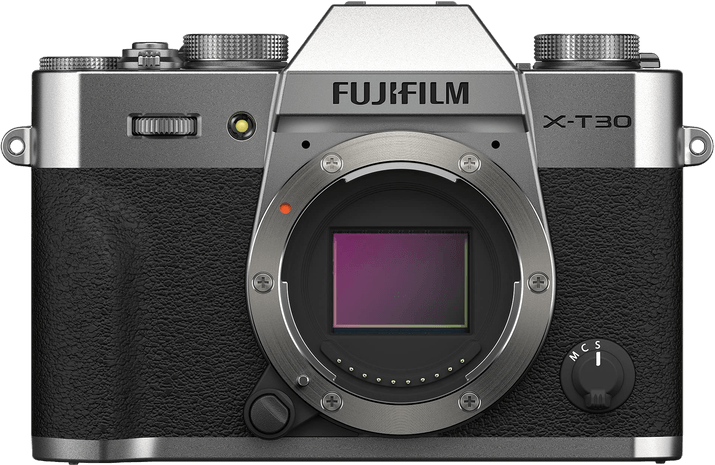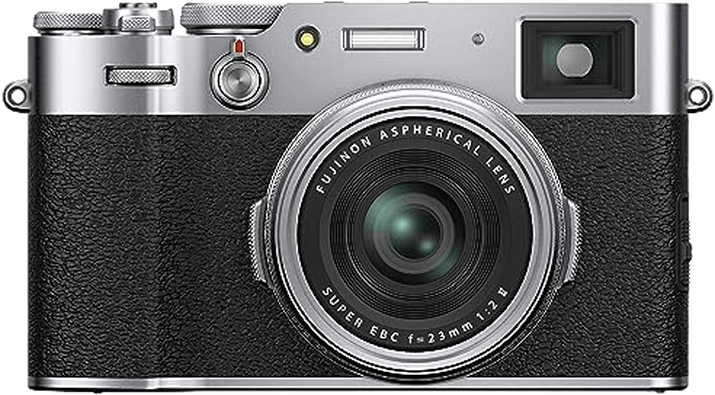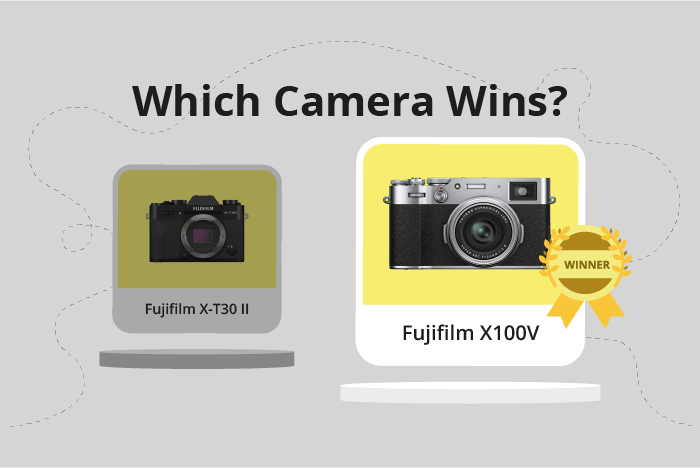Fujifilm X-T30 II vs X100V Comparison
Fujifilm X-T30 II

Fujifilm X100V

The Fujifilm X100V comes out on top with a score of 69/100, while the Fujifilm X-T30 II trails closely behind at 65/100. Both cameras share similarities as they are mirrorless, launched within a year of each other, and produced by the same manufacturer.
The X100V surpasses the X-T30 II in certain aspects, despite being an older model. However, the X-T30 II has its advantages, such as a lower launch price of $899 compared to the X100V’s $1399. Additionally, the X-T30 II is lighter and more compact, weighing only 383g and measuring 118 x 83 x 47mm.
Taking these factors into account, the Fujifilm X100V still emerges as the winner due to its higher score, but the Fujifilm X-T30 II proves to be a more budget-friendly and portable option.
Fujifilm X-T30 II vs X100V Overview and Optics
The Fujifilm X-T30 II wins the optics comparison with a score of 67/100, just one point ahead of the Fujifilm X100V at 66/100. Both cameras share several specifications, including 26-megapixel resolution, CMOS sensor type, X-Processor 4, APS-C sensor size, and the lack of image stabilization. Notably, neither camera has a DXOMARK score, as the organization does not evaluate Fujifilm cameras.
The X-T30 II outperforms the X100V in shooting speed, offering 30 frames per second (fps) compared to the X100V’s 11 fps. This difference allows the X-T30 II to capture fast-moving subjects with greater ease and accuracy. Additionally, the X-T30 II has a Fujifilm X lens mount, enabling users to switch lenses and adapt to various shooting scenarios.
On the other hand, the X100V has a fixed lens mount, which means the lens cannot be changed. This limitation makes the camera less versatile than the X-T30 II; however, it also simplifies the user experience and ensures consistent image quality from the built-in lens.
In terms of optics, the Fujifilm X-T30 II is the superior choice for photographers seeking versatility and faster shooting speeds. The interchangeable lens mount and higher fps make it well-suited for a range of photographic situations. Conversely, the Fujifilm X100V is ideal for those who prefer a simpler, more streamlined experience with a fixed lens. While it may not offer the same flexibility as the X-T30 II, the X100V still delivers impressive image quality and is a solid option for photographers who value simplicity.
Fujifilm X-T30 II vs X100V Video Performance
The Fujifilm X-T30 II and the Fujifilm X100V both have a video score of 91/100, making them equal in terms of video capabilities. They share several key specifications, including a max video resolution of 4K, max video dimensions of 4096 x 2160, a max video frame rate of 120fps, and built-in time-lapse functionality.
Despite their equal scores, there are some areas where one camera may outperform the other. The Fujifilm X-T30 II is better in terms of versatility, due to its interchangeable lens system. This allows users to adapt the camera to different shooting situations, providing more flexibility and creative options for videographers.
On the other hand, the Fujifilm X100V has a fixed lens, which can be seen as both an advantage and a disadvantage. The fixed lens simplifies the shooting process and ensures consistent video quality, but it also limits the camera’s versatility. However, the X100V is known for its compact design and portability, making it a great option for those who prioritize ease of use and mobility.
Both cameras are excellent choices for videography, with their high video scores and shared specifications. The Fujifilm X-T30 II may be more suitable for those seeking versatility and flexibility, while the Fujifilm X100V may be better suited for those who value simplicity and portability. Ultimately, the choice between these two cameras will depend on the user’s individual needs and preferences.
Fujifilm X-T30 II vs X100V Features and Benefits
The Fujifilm X100V takes the lead with a feature score of 85/100, while the Fujifilm X-T30 II scores 70/100. Both cameras share several similarities in features, including a 3-inch touchscreen, flip screen, WiFi, and Bluetooth connectivity. However, neither camera offers GPS functionality.
The X100V outperforms the X-T30 II in screen resolution, boasting 1,620,000 dots compared to the X-T30 II’s 1,040,000 dots. This higher resolution results in a sharper and more detailed display, providing a better user experience when previewing images or navigating the camera’s settings.
On the other hand, the X-T30 II does not surpass the X100V in any particular feature. However, it still offers a solid set of features that cater to various photography and videography needs. With a touchscreen, flip screen, and wireless connectivity options, the X-T30 II remains a competitive choice for users who value these functionalities.
Taking these differences into account, the Fujifilm X100V emerges as the superior camera in terms of features, thanks to its higher screen resolution. The X-T30 II, while not outshining the X100V, maintains a reliable set of features that cater to different users’ needs. Ultimately, the choice between these two cameras depends on the individual’s preferences and requirements, with the X100V being the more feature-rich option.
Fujifilm X-T30 II vs X100V Storage and Battery
The Fujifilm X100V wins the storage and battery comparison with a score of 37/100, while the Fujifilm X-T30 II scores slightly lower at 35/100. Both cameras share similar specifications, with a single memory card slot accepting SD, SDHC, and SDXC cards (UHS-I compatible). They also both have USB charging capabilities and use the NP-W126S battery type.
The X100V outperforms the X-T30 II in battery life, providing 420 shots compared to the X-T30 II’s 380 shots. This increased battery life makes the X100V more suitable for extended shooting sessions without needing to replace or recharge batteries as frequently.
The X-T30 II, although having a slightly lower battery life, still offers a decent number of shots per charge. It may be sufficient for casual photographers or those who do not require extended battery life for their shooting needs.
Considering these factors, the Fujifilm X100V is the better choice for photographers seeking longer battery life, while the Fujifilm X-T30 II remains a viable option for those who can manage with a slightly lower battery life.
Fujifilm X-T30 II vs X100V – Our Verdict
Are you still undecided about which camera is right for you? Have a look at these popular comparisons that feature the Fujifilm X-T30 II or the Fujifilm X100V:

